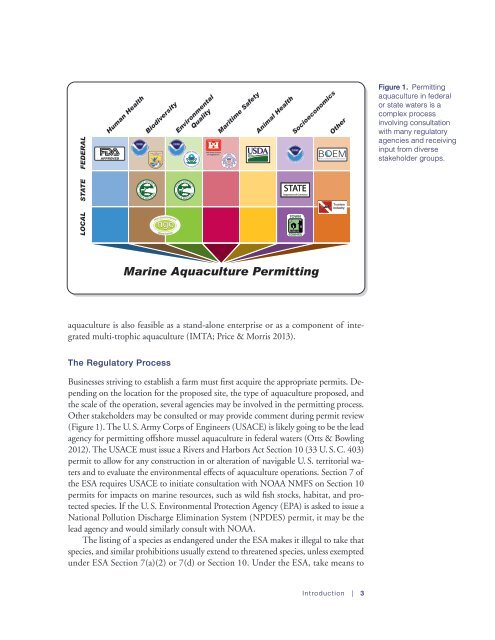Protected Species and Marine Aquaculture Interactions
x9Jh2
x9Jh2
You also want an ePaper? Increase the reach of your titles
YUMPU automatically turns print PDFs into web optimized ePapers that Google loves.
FEDERAL<br />
Human Health<br />
APPROVED<br />
Biodiversity<br />
Environmental<br />
Quality<br />
US Army Corps<br />
of Engineers®<br />
Maritime Safety<br />
Animal Health<br />
Socioeconomics<br />
Other<br />
B OEM<br />
BUREAU OF OCEAN ENERGY MANAGEMENT<br />
Figure 1. Permitting<br />
aquaculture in federal<br />
or state waters is a<br />
complex process<br />
involving consultation<br />
with many regulatory<br />
agencies <strong>and</strong> receiving<br />
input from diverse<br />
stakeholder groups.<br />
STATE<br />
STATE<br />
Department of Commerce<br />
LOCAL<br />
ngo<br />
<strong>Marine</strong> <strong>Aquaculture</strong> Permitting<br />
aquaculture is also feasible as a st<strong>and</strong>-alone enterprise or as a component of integrated<br />
multi-trophic aquaculture (IMTA; Price & Morris 2013).<br />
The Regulatory Process<br />
Businesses striving to establish a farm must first acquire the appropriate permits. Depending<br />
on the location for the proposed site, the type of aquaculture proposed, <strong>and</strong><br />
the scale of the operation, several agencies may be involved in the permitting process.<br />
Other stakeholders may be consulted or may provide comment during permit review<br />
(Figure 1). The U. S. Army Corps of Engineers (USACE) is likely going to be the lead<br />
agency for permitting offshore mussel aquaculture in federal waters (Otts & Bowling<br />
2012). The USACE must issue a Rivers <strong>and</strong> Harbors Act Section 10 (33 U. S. C. 403)<br />
permit to allow for any construction in or alteration of navigable U. S. territorial waters<br />
<strong>and</strong> to evaluate the environmental effects of aquaculture operations. Section 7 of<br />
the ESA requires USACE to initiate consultation with NOAA NMFS on Section 10<br />
permits for impacts on marine resources, such as wild fish stocks, habitat, <strong>and</strong> protected<br />
species. If the U. S. Environmental Protection Agency (EPA) is asked to issue a<br />
National Pollution Discharge Elimination System (NPDES) permit, it may be the<br />
lead agency <strong>and</strong> would similarly consult with NOAA.<br />
The listing of a species as endangered under the ESA makes it illegal to take that<br />
species, <strong>and</strong> similar prohibitions usually extend to threatened species, unless exempted<br />
under ESA Section 7(a)(2) or 7(d) or Section 10. Under the ESA, take means to<br />
introduction | 3


